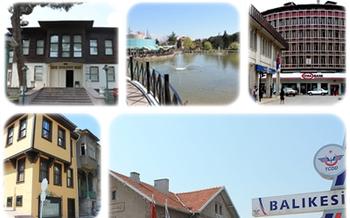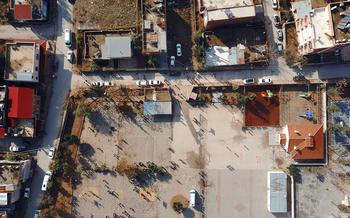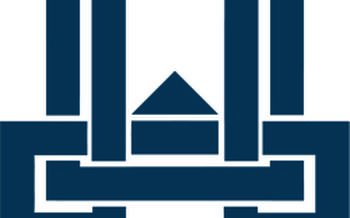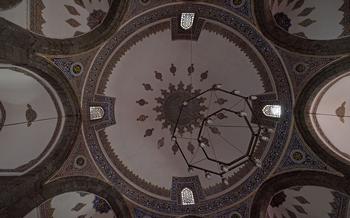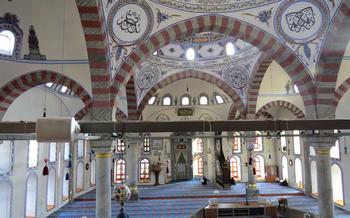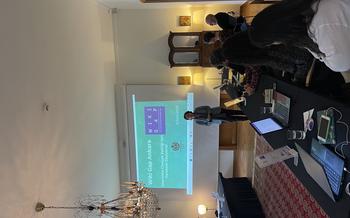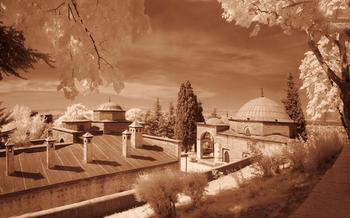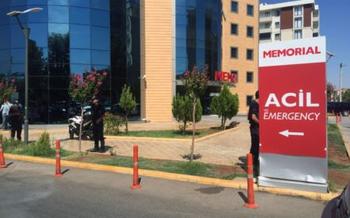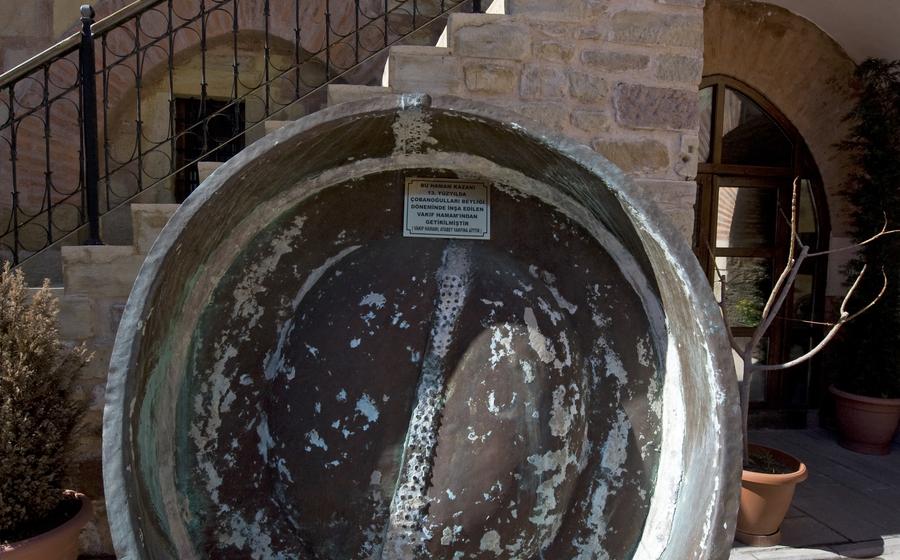
Kursunlu Mosque
- Historical Significance
- Architectural Marvel
- Religious Importance
- Cultural Symbol
- Tourism Destination
- Intricate Details
- Minaret
- Interior Beauty
- Historical Context
- Religious Practices
- Cultural Events
- Local Legends
- Restoration and Preservation
- Visitor Etiquette
- Insider Tip
Historical Significance
The Kursunlu Mosque stands as a testament to Kastamonu's rich cultural heritage, dating back to the Beylik period. Built in the 14th century, it embodies the architectural legacy of the Turkish Beyliks, showcasing their unique blend of Islamic and Anatolian influences. Its strategic location within the city center reflects its importance as a symbol of religious and cultural identity, serving as a focal point for the community to gather and worship. The mosque's architectural features, including its intricate stonework, elegant minaret, and spacious interior, exemplify the refined craftsmanship and artistry of the era, making it a must-visit destination for history and architecture enthusiasts.
Architectural Marvel
The Kursunlu Mosque stands as a testament to the architectural prowess of the Beylik period. Its striking facade, adorned with intricate stonework, immediately captures the attention of visitors. The mosque's minaret, a slender and graceful structure, rises high above the surrounding buildings, serving as a beacon of faith and devotion. The minaret's intricate carvings and elegant design reflect the mosque's overall architectural style, blending traditional Islamic motifs with local influences. One unique feature of the Kursunlu Mosque is its domed roof, a rare sight in Kastamonu's religious architecture. This distinctive feature adds to the mosque's visual appeal and sets it apart from other mosques in the region.
Religious Importance
The Kursunlu Mosque holds immense religious significance for Muslims in Kastamonu. It serves as a central place of worship for the city's Muslim community, fostering a sense of unity and spirituality among believers. The mosque's strategic location in the heart of Kastamonu symbolizes its importance as a religious landmark. Throughout the week, the mosque's interior reverberates with the melodious call to prayer, echoing through the city streets and reminding the faithful of their religious duties. During significant Islamic holidays and festivals, such as Eid al-Fitr and Eid al-Adha, the mosque becomes a vibrant hub of religious celebrations, attracting worshippers from across the region. These events showcase the deep-rooted Islamic traditions and customs that are an integral part of Kastamonu's cultural heritage.
Cultural Symbol
The Kursunlu Mosque stands as a testament to Kastamonu's rich cultural heritage. Its architectural style, intricate carvings, and historical significance have made it an enduring symbol of the city's identity. Locals take great pride in this architectural masterpiece, which has become an integral part of their cultural fabric. Over the centuries, the mosque has witnessed countless religious ceremonies, festivals, and community gatherings, further solidifying its position as a central hub for social and cultural exchange in Kastamonu.
Legends and stories surrounding the mosque have been passed down through generations, adding to its mystique and allure. One popular tale speaks of a pious man who had a vision of a magnificent mosque on this very spot. Inspired by his dream, he devoted his life to raising funds and overseeing its construction, ensuring that the mosque would become a reality. Such stories have woven the Kursunlu Mosque into the tapestry of Kastamonu's cultural identity, making it a beloved and cherished landmark for locals and visitors alike.
Tourism Destination
The Kursunlu Mosque stands as a must-visit destination for those captivated by history and architecture. Its unique architectural style, rich cultural significance, and serene atmosphere make it a popular attraction among tourists visiting Kastamonu. The mosque welcomes visitors from all backgrounds, offering them a glimpse into the city's rich heritage. Visitors can explore the mosque's intricate details, admire its stunning minaret, and immerse themselves in the tranquility of its interior. Guided tours are available for those seeking a deeper understanding of the mosque's history and significance. The mosque is open to the public during specific hours, and a nominal entrance fee is charged for maintenance and preservation purposes.
Intricate Details
The Kursunlu Mosque is adorned with intricate carvings and decorations that showcase the exceptional craftsmanship of its builders. The exterior walls are adorned with elaborate stone carvings, featuring geometric patterns, floral motifs, and verses from the Quran. The interior is equally impressive, with its finely carved wooden mihrab, the niche that indicates the direction of Mecca. The mihrab is intricately decorated with arabesques, calligraphy, and geometric designs, creating a stunning focal point within the mosque. The mosque's interior is further embellished by an array of colorful Iznik tiles, which adorn the walls and the dome. These tiles feature intricate patterns and vibrant colors, adding a touch of elegance and grandeur to the mosque's interior.
Minaret
The Kursunlu Mosque boasts a towering minaret that stands as a testament to Islamic architectural prowess. Its slender, cylindrical form rises majestically towards the heavens, reaching an impressive height that dominates the Kastamonu skyline. The minaret's intricate stonework showcases the exceptional craftsmanship of its builders, with geometric patterns and Quranic inscriptions adorning its surface. As the muezzin's call to prayer reverberates through the air, echoing from the minaret's balcony, the faithful are reminded of their religious obligations and the mosque's central role in the community. The minaret not only serves as a functional element for the mosque but also stands as a symbol of devotion and spiritual connection, inviting the faithful to join in prayer and worship.
Interior Beauty
The interior of the Kursunlu Mosque is a testament to its architectural elegance and spiritual grandeur. Upon entering, visitors are greeted by a spacious and serene atmosphere, inviting contemplation and prayer. The mosque's vast interior is adorned with intricate tilework, calligraphy, and geometric patterns, creating a visually captivating environment. The central dome, supported by graceful arches, rises high above, adding to the sense of majesty and spaciousness.
The mihrab, or prayer niche, is a focal point of the mosque, intricately carved with verses from the Quran and adorned with colorful tiles. The minbar, or pulpit, is an exquisite example of craftsmanship, featuring delicate carvings and intricate designs. The chandeliers, suspended from the ceiling, cast a warm glow, illuminating the interior with a soft, ethereal light.
The overall design of the interior complements the mosque's architectural style, creating a harmonious and awe-inspiring space for worship and contemplation. Visitors can spend hours exploring the intricate details and admiring the beauty of the mosque's interior, which is a true testament to the skill and artistry of its builders.
Historical Context
Kastamonu, a city steeped in history and cultural heritage, played a significant role during the Beylik period, a time of political fragmentation and the rise of independent principalities in Anatolia. It was during this era, in the 14th century, that the Kursunlu Mosque was constructed, reflecting the city's growing importance and prosperity. The mosque stands as a testament to the architectural achievements and religious fervor of the Beylik rulers, who left an indelible mark on Kastamonu's history and laid the foundation for its future development. The construction of the mosque was a testament to the city's growing power and influence, and it remains a symbol of Kastamonu's rich architectural heritage.
Religious Practices
The Kursunlu Mosque is a vibrant center of religious activity, hosting various practices that reflect the deep devotion of the Muslim community. Daily prayers, including the five mandatory ones, are performed in the mosque, with a large number of worshippers in attendance. The atmosphere during these prayers is serene and spiritual, as the faithful gather to connect with their Creator and seek His guidance.
In addition, special ceremonies and events are held at the mosque to commemorate important religious occasions. These events include the celebration of religious holidays, such as Eid al-Fitr and Eid al-Adha, as well as the observance of holy nights, such as Laylat al-Qadr. During these occasions, the mosque is adorned with beautiful decorations, and special prayers and recitations are performed. These ceremonies provide an opportunity for the community to come together and celebrate their faith in a collective and meaningful way.
Cultural Events
The Kursunlu Mosque is not only a religious site but also a venue for cultural events that showcase Kastamonu's rich heritage. During the holy month of Ramadan, the mosque hosts special Tarawih prayers, where Muslims gather to recite the entire Quran over the course of the month. These prayers are accompanied by melodious Quranic recitations and create a spiritual atmosphere that attracts worshippers from across the city.
Additionally, the mosque organizes various cultural programs throughout the year, including lectures, workshops, and exhibitions. These events provide a platform for local artists, scholars, and historians to share their knowledge and expertise on Islamic art, architecture, and history. Visitors can attend these events to gain insights into the mosque's significance and the broader cultural context of Kastamonu.
Local Legends
The Kursunlu Mosque is intertwined with intriguing local legends that have been passed down through generations. One captivating tale speaks of a hidden treasure buried beneath the mosque's foundations. According to legend, a wealthy merchant who sought refuge in Kastamonu during tumultuous times entrusted his vast wealth to the mosque's imam for safekeeping. Tragically, the merchant passed away before he could return, and the treasure remains hidden to this day. Locals believe that the treasure holds the power to bring prosperity and good fortune to whoever discovers it, making it a popular subject of speculation and curiosity among residents and visitors alike.
Restoration and Preservation
The Kursunlu Mosque has undergone several restoration and preservation efforts to maintain its historical and cultural integrity. In the early 20th century, the mosque's minaret was in danger of collapse due to structural damage. It was extensively repaired and reinforced to ensure its stability. In the 1970s, the mosque's interior was renovated, focusing on preserving its original architectural features. The intricate stonework and carvings were carefully restored, and the mihrab and minbar were repaired and polished. These efforts have ensured that the mosque retains its historical charm while remaining a functional place of worship for the local Muslim community.
Visitor Etiquette
When visiting the Kursunlu Mosque, it is essential to be respectful of the local customs and traditions. As a place of worship, visitors should dress modestly and avoid wearing revealing clothing. It is also important to maintain a quiet and reverent atmosphere within the mosque. Photography is permitted, but visitors should refrain from using flash or taking pictures of people without their consent. Visitors should also be mindful of the prayer times and avoid entering the mosque during these periods unless they are participating in prayer. By following these guidelines, visitors can ensure that they have a respectful and enriching experience at the Kursunlu Mosque.
Insider Tip
As I wandered through the tranquil courtyard of the Kursunlu Mosque, I stumbled upon a hidden gem that few visitors know about. Tucked away in a secluded corner, I discovered a small fountain adorned with intricate carvings and sparkling tiles. According to a local guide, this fountain holds a special significance for the community. It is said that the water from this fountain possesses healing properties and is believed to bring good luck and prosperity to those who drink from it. As I took a sip of the cool, refreshing water, I couldn't help but feel a sense of peace and tranquility wash over me. It was a moment of pure bliss that I will cherish forever.
